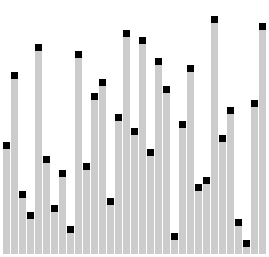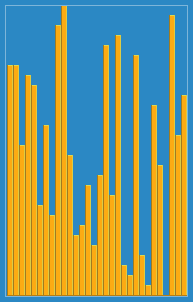|
Comb Sort
Comb sort is a relatively simple sorting algorithm originally designed by Włodzimierz Dobosiewicz and Artur Borowy in 1980, later rediscovered (and given the name "Combsort") by Stephen Lacey and Richard Box in 1991. Comb sort improves on bubble sort in the same way that Shellsort improves on insertion sort. '' nist.govs "diminishing increment sort" definition mentions the term 'comb sort' as visualizing iterative passes of the data, "where the teeth of a comb touch;" the former term is linked to Don Knuth. Algorithm The basic idea is to eliminate ''turtles'', or small values near the end of the list, since in a bubble sort these slow the sorting down tremendously. ''Rabbits'', large values around the beginning of the list, do not pose a problem in bubble sort. In bubble sort, when any two elements are compared, they always have a ''gap'' (distance from each other) of 1. The basic idea of comb sort is that the gap can be much more than 1. The inner loop of bubble sort, which d ... [...More Info...] [...Related Items...] OR: [Wikipedia] [Google] [Baidu] |
Sorting Algorithm
In computer science, a sorting algorithm is an algorithm that puts elements of a list into an order. The most frequently used orders are numerical order and lexicographical order, and either ascending or descending. Efficient sorting is important for optimizing the efficiency of other algorithms (such as search and merge algorithms) that require input data to be in sorted lists. Sorting is also often useful for canonicalizing data and for producing human-readable output. Formally, the output of any sorting algorithm must satisfy two conditions: # The output is in monotonic order (each element is no smaller/larger than the previous element, according to the required order). # The output is a permutation (a reordering, yet retaining all of the original elements) of the input. For optimum efficiency, the input data should be stored in a data structure which allows random access rather than one that allows only sequential access. History and concepts From the beginning of c ... [...More Info...] [...Related Items...] OR: [Wikipedia] [Google] [Baidu] |
National Institute Of Standards And Technology
The National Institute of Standards and Technology (NIST) is an agency of the United States Department of Commerce whose mission is to promote American innovation and industrial competitiveness. NIST's activities are organized into Outline of physical science, physical science laboratory programs that include Nanotechnology, nanoscale science and technology, engineering, information technology, neutron research, material measurement, and physical measurement. From 1901 to 1988, the agency was named the National Bureau of Standards. History Background The Articles of Confederation, ratified by the colonies in 1781, provided: The United States in Congress assembled shall also have the sole and exclusive right and power of regulating the alloy and value of coin struck by their own authority, or by that of the respective states—fixing the standards of weights and measures throughout the United States. Article 1, section 8, of the Constitution of the United States, ratified in ... [...More Info...] [...Related Items...] OR: [Wikipedia] [Google] [Baidu] |
Sorting Algorithms
In computer science, a sorting algorithm is an algorithm that puts elements of a list into an order. The most frequently used orders are numerical order and lexicographical order, and either ascending or descending. Efficient sorting is important for optimizing the efficiency of other algorithms (such as search and merge algorithms) that require input data to be in sorted lists. Sorting is also often useful for canonicalizing data and for producing human-readable output. Formally, the output of any sorting algorithm must satisfy two conditions: # The output is in monotonic order (each element is no smaller/larger than the previous element, according to the required order). # The output is a permutation (a reordering, yet retaining all of the original elements) of the input. For optimum efficiency, the input data should be stored in a data structure which allows random access rather than one that allows only sequential access. History and concepts From the beginning of ... [...More Info...] [...Related Items...] OR: [Wikipedia] [Google] [Baidu] |
Cocktail Sort
Cocktail shaker sort, also known as bidirectional bubble sort, cocktail sort, shaker sort (which can also refer to a variant of selection sort), ripple sort, shuffle sort, or shuttle sort, is an extension of bubble sort. The algorithm extends bubble sort by operating in two directions. While it improves on bubble sort by more quickly moving items to the beginning of the list, it provides only marginal performance improvements. Like most variants of bubble sort, cocktail shaker sort is used primarily as an educational tool. More performant algorithms such as quicksort, merge sort, or timsort are used by the sorting libraries built into popular programming languages such as Python and Java. Pseudocode The simplest form goes through the whole list each time: procedure cocktailShakerSort(A : list of sortable items) is do swapped := false for each i in 0 to length(A) − 2 do: if A > A + 1then swap(A A + 1 ... [...More Info...] [...Related Items...] OR: [Wikipedia] [Google] [Baidu] |
Bubble Sort
Bubble sort, sometimes referred to as sinking sort, is a simple sorting algorithm that repeatedly steps through the input list element by element, comparing the current element with the one after it, swapping their values if needed. These passes through the list are repeated until no swaps had to be performed during a pass, meaning that the list has become fully sorted. The algorithm, which is a comparison sort, is named for the way the larger elements "bubble" up to the top of the list. This simple algorithm performs poorly in real world use and is used primarily as an educational tool. More efficient algorithms such as quicksort, timsort, or merge sort are used by the sorting libraries built into popular programming languages such as Python and Java. Analysis Performance Bubble sort has a worst-case and average complexity of O(n^2), where n is the number of items being sorted. Most practical sorting algorithms have substantially better worst-case or average complexity ... [...More Info...] [...Related Items...] OR: [Wikipedia] [Google] [Baidu] |
Swap (computer Science)
In computer programming, the act of swapping two variables refers to mutually exchanging the values of the variables. Usually, this is done with the data in memory. For example, in a program, two variables may be defined thus (in pseudocode): data_item x := 1 data_item y := 0 swap (x, y); After swap() is performed, ''x'' will contain the value 0 and ''y'' will contain 1; their values have been exchanged. This operation may be generalized to other types of values, such as strings and aggregated data types. Comparison sorts use swaps to change the positions of data. In many programming languages the swap function is built-in. In C++, overloads are provided allowing std::swap to exchange some large structures in O(1) time. Using a temporary variable The simplest and probably most widely used method to swap two variables is to use a third temporary variable: define swap (x, y) temp := x x := y y := temp While this is conceptually simple and in many cases t ... [...More Info...] [...Related Items...] OR: [Wikipedia] [Google] [Baidu] |
Shell Sort
Shellsort, also known as Shell sort or Shell's method, is an in-place comparison sort. It can be seen as either a generalization of sorting by exchange (bubble sort) or sorting by insertion (insertion sort). The method starts by sorting pairs of elements far apart from each other, then progressively reducing the gap between elements to be compared. By starting with far apart elements, it can move some out-of-place elements into position faster than a simple nearest neighbor exchange. Donald Shell published the first version of this sort in 1959. The running time of Shellsort is heavily dependent on the gap sequence it uses. For many practical variants, determining their time complexity remains an open problem. Description Shellsort is an optimization of insertion sort that allows the exchange of items that are far apart. The idea is to arrange the list of elements so that, starting anywhere, taking every ''h''th element produces a sorted list. Such a list is said to be ''h''-s ... [...More Info...] [...Related Items...] OR: [Wikipedia] [Google] [Baidu] |
Donald Knuth
Donald Ervin Knuth ( ; born January 10, 1938) is an American computer scientist, mathematician, and professor emeritus at Stanford University. He is the 1974 recipient of the ACM Turing Award, informally considered the Nobel Prize of computer science. Knuth has been called the "father of the analysis of algorithms". He is the author of the multi-volume work '' The Art of Computer Programming'' and contributed to the development of the rigorous analysis of the computational complexity of algorithms and systematized formal mathematical techniques for it. In the process, he also popularized the asymptotic notation. In addition to fundamental contributions in several branches of theoretical computer science, Knuth is the creator of the TeX computer typesetting system, the related METAFONT font definition language and rendering system, and the Computer Modern family of typefaces. As a writer and scholar, Knuth created the WEB and CWEB computer programming systems designed to ... [...More Info...] [...Related Items...] OR: [Wikipedia] [Google] [Baidu] |
Insertion Sort
Insertion sort is a simple sorting algorithm that builds the final sorted array (or list) one item at a time by comparisons. It is much less efficient on large lists than more advanced algorithms such as quicksort, heapsort, or merge sort. However, insertion sort provides several advantages: * Simple implementation: Jon Bentley shows a three-line C/ C++ version that is five lines when optimized. * Efficient for (quite) small data sets, much like other quadratic (i.e., O(''n''2)) sorting algorithms * More efficient in practice than most other simple quadratic algorithms such as selection sort or bubble sort * Adaptive, i.e., efficient for data sets that are already substantially sorted: the time complexity is O(''kn'') when each element in the input is no more than places away from its sorted position * Stable; i.e., does not change the relative order of elements with equal keys * In-place; i.e., only requires a constant amount O(1) of additional memory space * Online; ... [...More Info...] [...Related Items...] OR: [Wikipedia] [Google] [Baidu] |
Comb Sort Demo
A comb is a tool consisting of a shaft that holds a row of teeth for pulling through the hair to clean, untangle, or style it. Combs have been used since prehistoric times, having been discovered in very refined forms from settlements dating back to 5,000 years ago in Persia. Weaving combs made of whalebone dating to the middle and late Iron Age have been found on archaeological digs in Orkney and Somerset. Description Combs consist of a shaft and teeth that are placed at a perpendicular angle to the shaft. Combs can be made out of a number of materials, most commonly plastic, metal, or wood. In antiquity, horn and whalebone was sometimes used. Combs made from ivory and tortoiseshell were once common but concerns for the animals that produce them have reduced their usage. Wooden combs are largely made of boxwood, cherry wood, or other fine-grained wood. Good quality wooden combs are usually handmade and polished. Combs come in various shapes and sizes depending on what the ... [...More Info...] [...Related Items...] OR: [Wikipedia] [Google] [Baidu] |
Shellsort
Shellsort, also known as Shell sort or Shell's method, is an in-place comparison sort. It can be seen as either a generalization of sorting by exchange (bubble sort) or sorting by insertion ( insertion sort). The method starts by sorting pairs of elements far apart from each other, then progressively reducing the gap between elements to be compared. By starting with far apart elements, it can move some out-of-place elements into position faster than a simple nearest neighbor exchange. Donald Shell published the first version of this sort in 1959. The running time of Shellsort is heavily dependent on the gap sequence it uses. For many practical variants, determining their time complexity remains an open problem. Description Shellsort is an optimization of insertion sort that allows the exchange of items that are far apart. The idea is to arrange the list of elements so that, starting anywhere, taking every ''h''th element produces a sorted list. Such a list is said to be ''h' ... [...More Info...] [...Related Items...] OR: [Wikipedia] [Google] [Baidu] |
Bubble Sort
Bubble sort, sometimes referred to as sinking sort, is a simple sorting algorithm that repeatedly steps through the input list element by element, comparing the current element with the one after it, swapping their values if needed. These passes through the list are repeated until no swaps had to be performed during a pass, meaning that the list has become fully sorted. The algorithm, which is a comparison sort, is named for the way the larger elements "bubble" up to the top of the list. This simple algorithm performs poorly in real world use and is used primarily as an educational tool. More efficient algorithms such as quicksort, timsort, or merge sort are used by the sorting libraries built into popular programming languages such as Python and Java. Analysis Performance Bubble sort has a worst-case and average complexity of O(n^2), where n is the number of items being sorted. Most practical sorting algorithms have substantially better worst-case or average complexity ... [...More Info...] [...Related Items...] OR: [Wikipedia] [Google] [Baidu] |








.jpg)
